CRO testing can serve as the deciding factor when it comes to maximizing the efficiency of your website and landing page transformations. It guides you towards the most fruitful outcomes based on primary objectives, becoming vital to any online strategy.
Unfortunately, many marketers hesitate to explore conversion rate optimization because they lack a clear starting point for custom-made tests for each business.
In turn, this can lead to missed opportunities.
Data indicates that the average conversion rate for a typical website hovers around 2.35%. Meanwhile, Hubspot reveals that the average landing page conversion scales significantly higher, at 9.7%.
Irrespective of your current metrics, optimizing your marketing outcomes must remain a constant priority. It ensures that you prepare for fluctuating consumer expectations and trends.
The sheer volume of testable metrics can be daunting. Yet, when the structure of CRO testing is fully understood, its worth becomes abundantly evident.
This article aims to encourage those who have found implementing CRO on their website and landing pages intimidating but know deep down it’s time to take the leap.
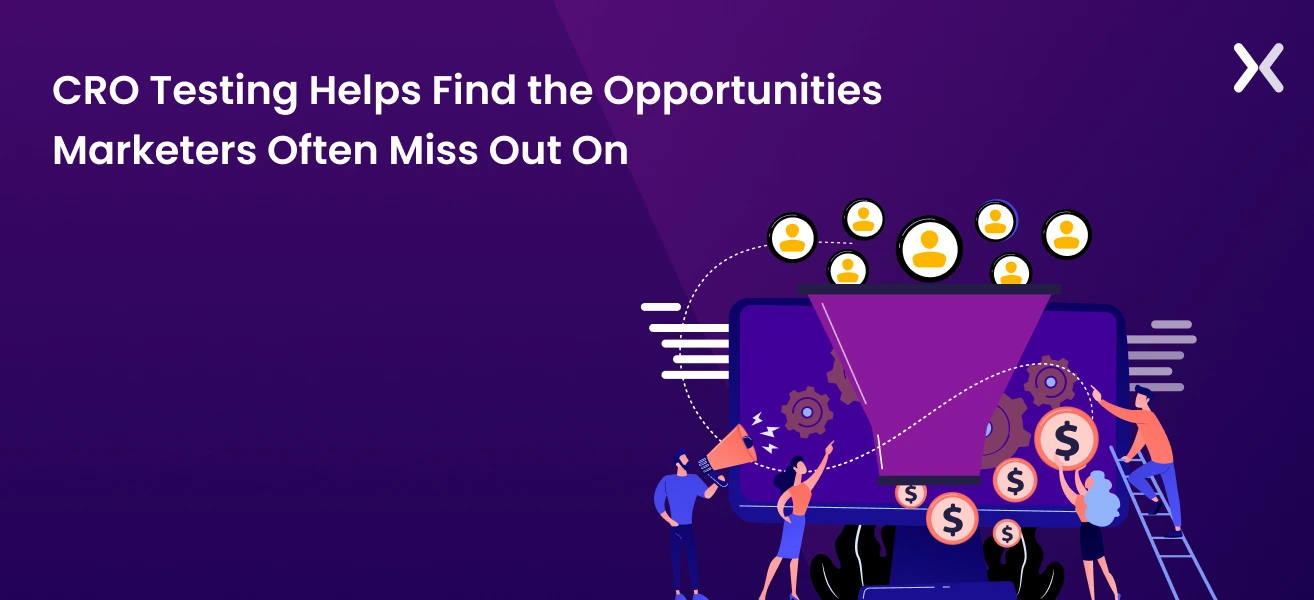
Conversion rate optimization (CRO) is a process that helps you amplify your website or landing page’s efficiency. It could be anything from a visitor completing a purchase to signing up for a newsletter, filling out a form, or any other goal set by your business.
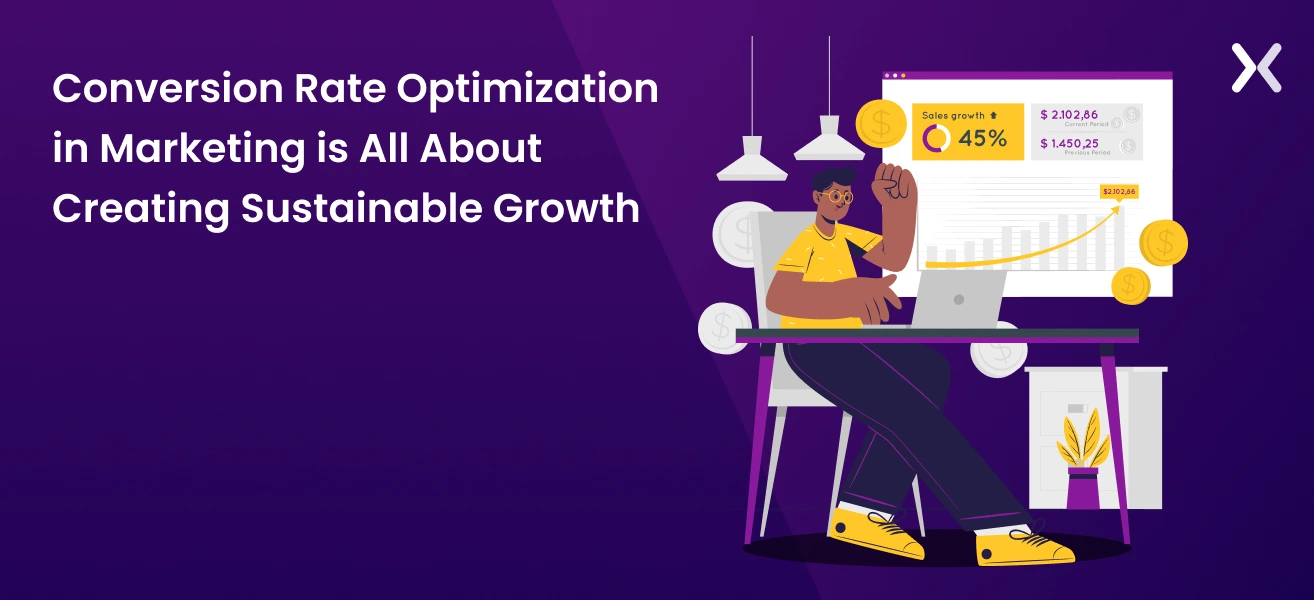
For any online enterprise, CRO is a linchpin. It matters little whether your business is in the startup phase or a sprawling corporation – the objective remains the same.
It’s not just about aimlessly achieving more conversions. It’s about doing it successfully, meaningfully, and consistently.
CRO testing is a user-testing approach employed to identify opportunities to amplify conversion rates – whether on a landing page, homepage, or any other webpage. Essentially, a CRO test uses several methodologies to pinpoint the version of a webpage that attracts the highest quality of traffic.
The primary objective is to systematically test different elements and variants, understanding what stimulates visitors to take the desired action.
The scope of CRO tests covers a wide variety of tasks. It might involve the following, for example:
Within the broader framework of the entire CRO process, a CRO test is the pivotal chapter before the grand finale of monitoring the results. It follows an intensive period of research and analysis.
This preliminary stage involves diving deep into user behavior, detecting friction points, and unveiling golden opportunities for enhancement.
Navigating CRO testing requires a keen understanding of its three main forms:
Direct Testing
UI/UX Testing
Methodical Testing
These three types can be further segmented into numerous subtypes, further enriching the versatile toolbox of any savvy marketer. Now, let’s delve into the nuances of each.
Direct testing methods revolve around live testing your hypotheses and ideas for your landing pagesand websites.
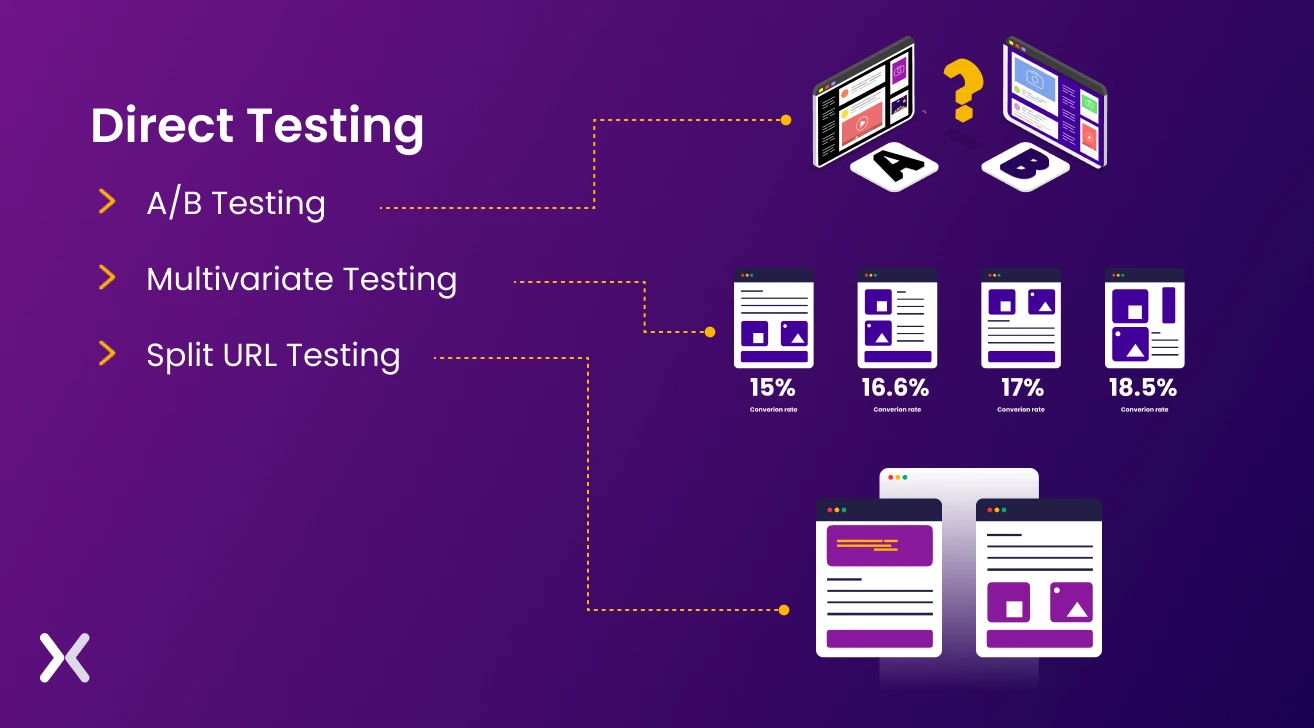
Description: This is essentially a battle of elements. You’re pitting two versions of a webpage (A and B) against each other, varying just one element (like the call-to-action, the headline, or the color scheme). The champion is the one that scores higher on conversions.
Use Case: Whenever you’re curious about how tweaking one specific element might sway user behavior, A/B testing is your best bet.
Description: Instead of understanding how one change impacts conversions, multivariate testing discovers how a combination of changes works together.
Use Case: It’s employed when multiple elements may influence conversions, and you want to determine the most effective combination.
Description: With this type of testing, you’re not just modifying an element on a page; you’re building two completely unique web pages.
Use Case: Use this when you’re ready to test radically different page designs or layouts.
User experience is crucial for all types of web pages. UI/UX testing helps you visualize how your users might navigate through your website.
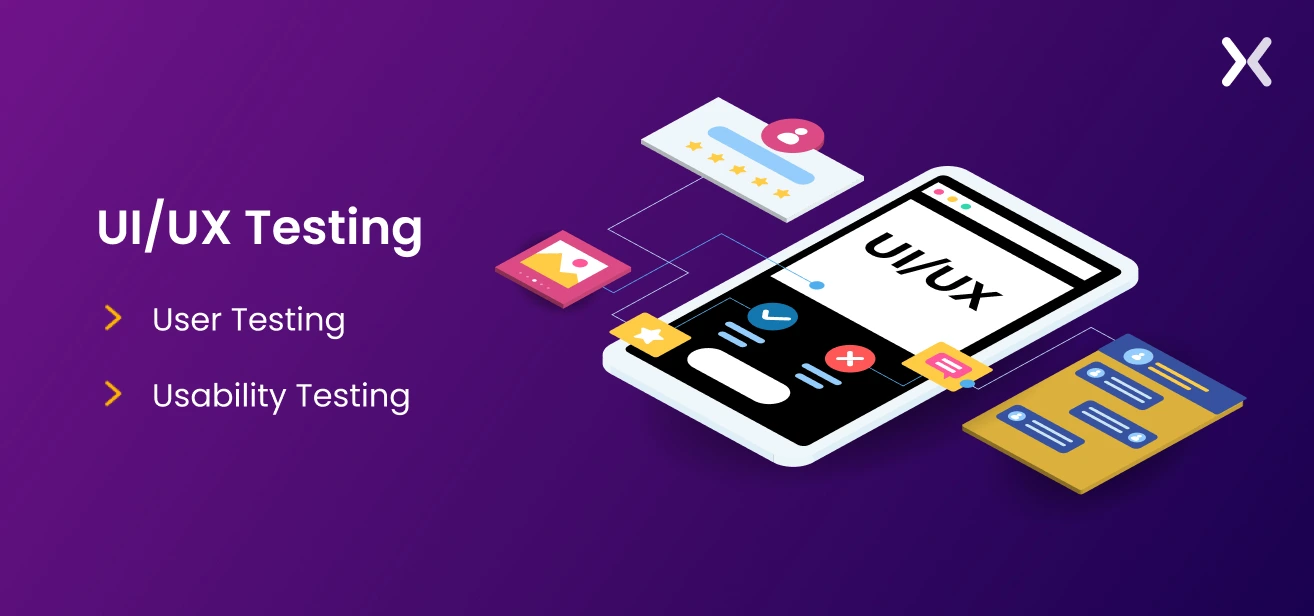
Description: Similar to conversing with your website’s visitors, this hands-on approach lets you have direct observations and feedback from real users navigating your website.
Use Case: Tap into user testing when you’re looking to understand user experiences in-depth, unveil problem areas, and highlight which facets need a touch-up.
Description: Compared to the widened approach of user testing, usability testing zeroes in on how effortlessly users can achieve specific tasks on a website or landing page. In turn, you’ll know which usability problems hinder conversions.
Use Case: Go for this if you suspect that issues with the ease of use are putting a damper on your conversion rates.
Methodical testing helps businesses that are conducting CRO tests with a goal.
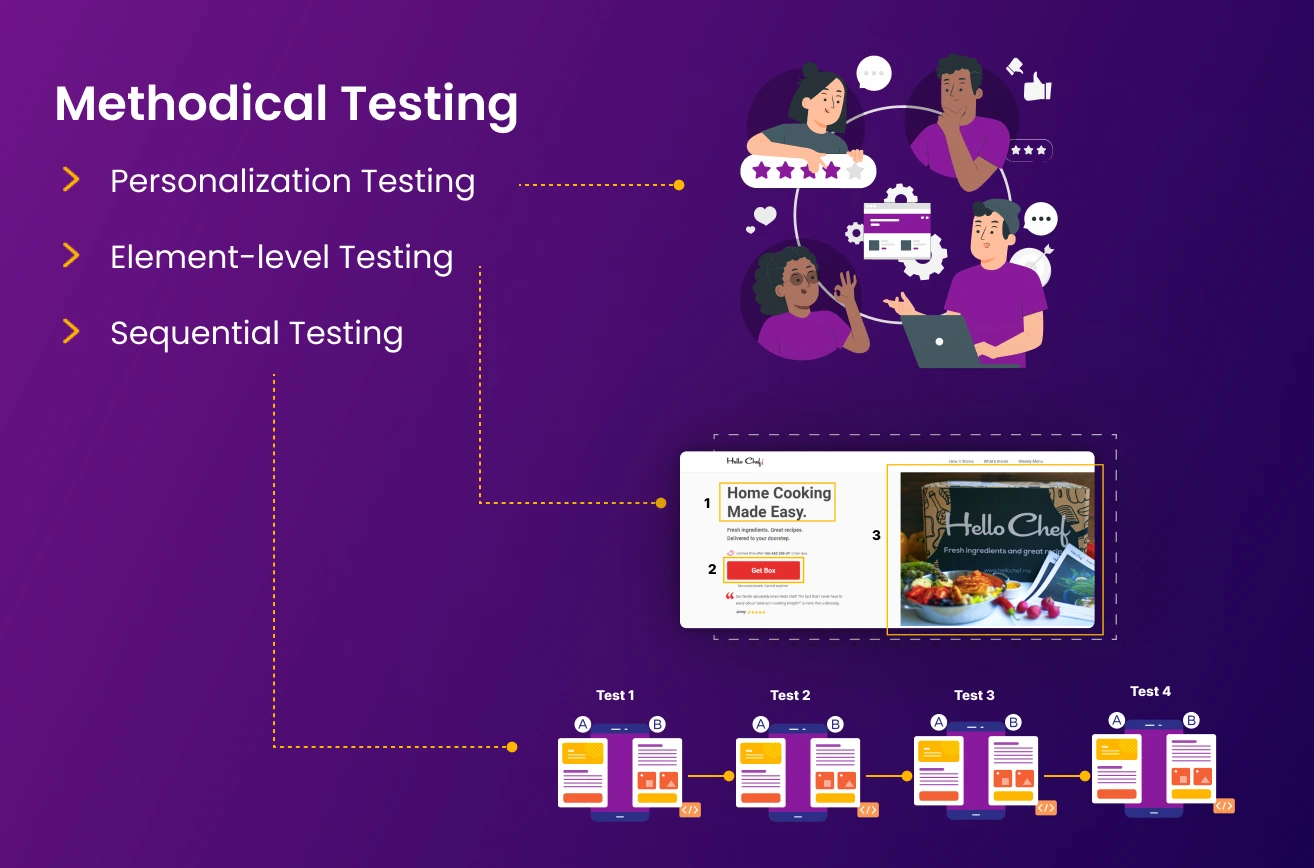
Description: Through personalization testing, you’re essentially crafting distinct content, deals, or experiences based on your visitors’ unique traits or behaviors.
Use Case: Go down this road when you’re keen to architect bespoke experiences that hit the sweet spot for distinctive segments of your audience.
Description: Think of element-level testing as spotlighting specific components of your webpage, like headlines, buttons, images, or forms. It’s about testing these individual aspects to see which one brings in more conversions.
Use Case: This is useful when there’s a particular element that you believe could turn the tide when it comes to conversions.
Description: The foundation of this testing is based on insights from previous testing, which is used to formulate a series of tests in a specific succession. It’s essentially creating a thoughtful and multi-layered CRO testing plan.
Use Case: Is there a logical sequence of changes required for your webpage? Sequential testing should be your tactic of choice, as it smartly harnesses the power of a systematic and strategy-focused approach.
While A/B testing undoubtedly plays a pivotal role in CRO, it’s just a fraction of the story. CRO paints a more expansive picture, incorporating numerous strategies beyond just A/B tests.
So, when you’re prepping for your next round of CRO testing, remember the full arsenal of tests at your disposal. Go ahead and deploy your A/B tests, but don’t forget to consider the other seven powerful tactics we’ve also explored.

Embarking on a CRO testing journey can start from any webpage. However, there are four frequent starting points that most marketers lean toward:
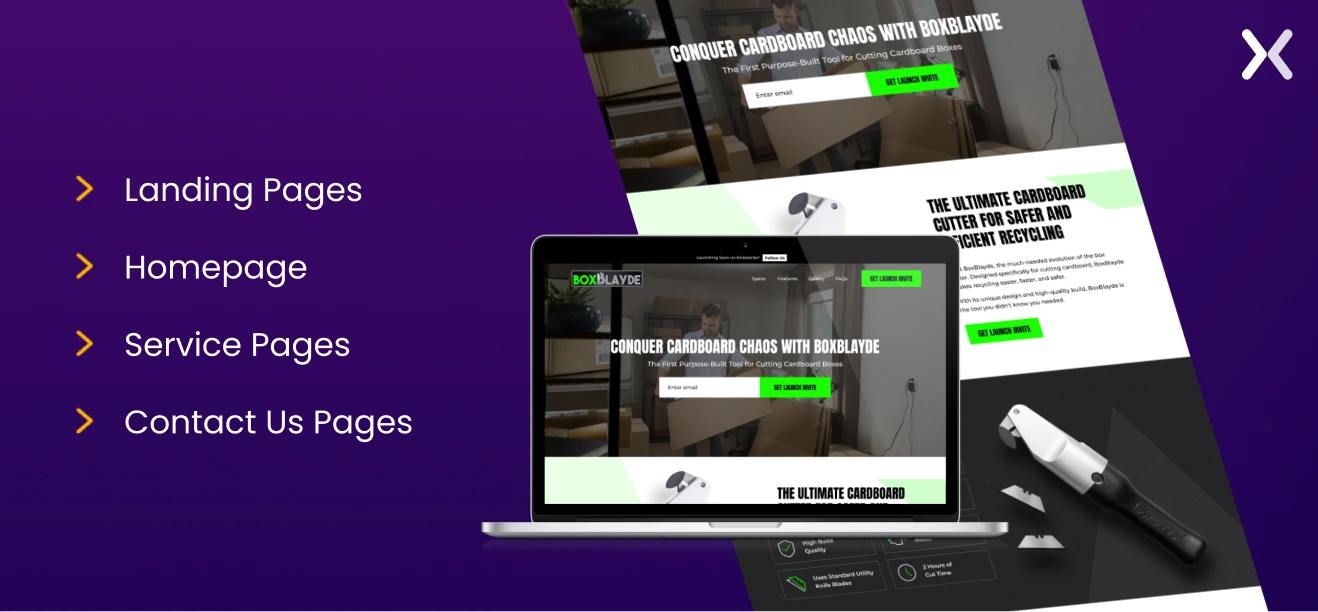
Often seen as the frontline soldiers of marketing and PPC campaigns, landing pages are purpose-built to shepherd visitors towards a specified action—a purchase, webinar sign-up, free trial sign-up, booking a demo, or eBook download.
Launching a CRO testing initiative on your landing pages is a smart move to ensure you get the most bang for your marketing buck.
The digital handshake of your brand, homepages, offers visitors the first taste. They must present a crisp, compelling brand snapshot while guiding visitors further. A CRO testing plan ensures no compromise in its quality.
Service pages offer a deep dive into your product or service offerings. A crucial part of the buyer’s journey, they persuade visitors to pick a specific offering. With CRO testing, elements like USPs and social proof find their optimal place.
This page serves as a bridge between your business and your audience, inviting engagement and connection. Implementing CRO testing on even the most straightforward elements of a Contact Us page, such as the form placement or call-to-action, can result in noticeable improvements in conversion rates.
Prepping for a successful CRO testing initiative isn’t just about strategy. It also requires the proper arsenal of technology. Here’s a list of some indispensable CRO testing tools that can bolster the effectiveness of your efforts:
These CRO testing tools provide information about website traffic, user actions, and conversion data. They are essential in charting user pathways, pinpointing traffic origins, gauging the impact of marketing strategies, and becoming a cornerstone in shaping CRO testing hypotheses.
Key Features:
Traffic Sources: Track the origins of web visitors, whether they’re finding you via organic search, paid promotions, or referrals.
Conversion Tracking: Keep tabs on user actions on your site, like form fill-ups or purchasing activities.
Use Cases:
Examining the effectiveness of marketing campaigns.
Spotting high-performance and underperforming pages.
Popular Tools
Google Analytics
Google Search Console
As they help you directly tap into the thoughts and feelings of your website and landing page visitors, user surveys and feedback tools make an excellent addition to your set of CRO testing tools. They unearth qualitative data, serving as a valuable aid in revealing user friction points and preferences.
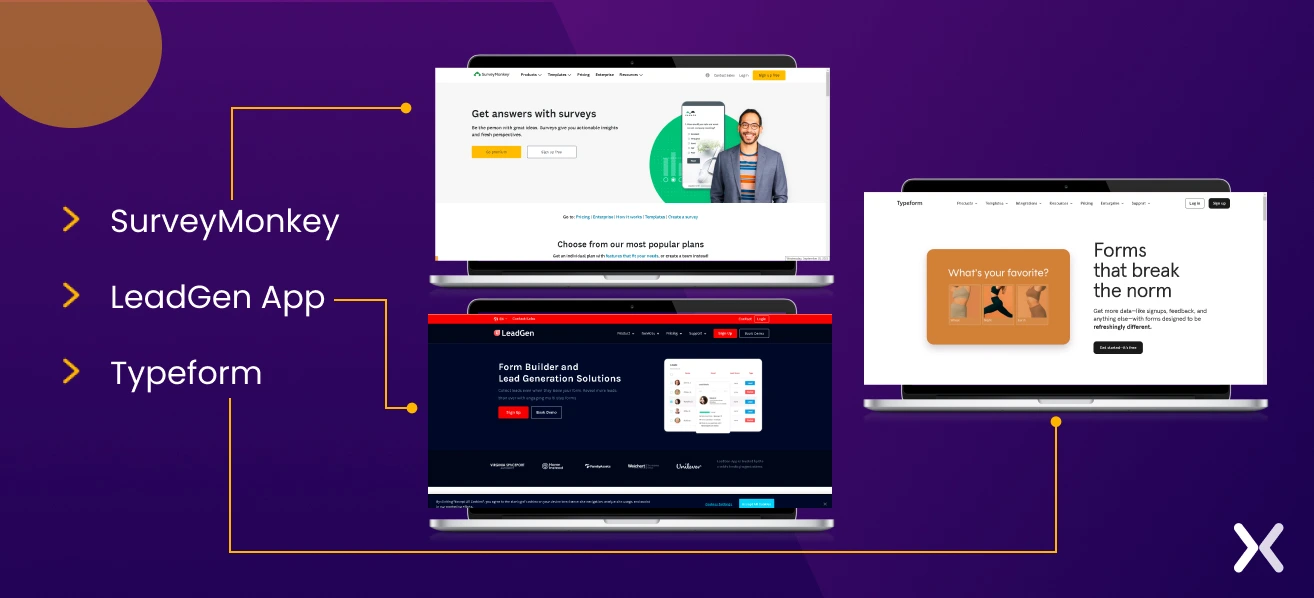
Key Features:
Survey Creation: Crafting bespoke surveys with a multitude of question formats.
Feedback Forms: Gathering user ideas and feedback in real-time.
Targeting and Triggering: Surveys dictated by specific user behaviors or set criteria.
Reporting and Analysis: Evaluation of survey responses and data feedback.
Use Cases:
Understanding the primary motivations, worries, and needs of users.
Identifying friction points or potential confusion areas on your website.
Popular Tools:
SurveyMonkey
Leadgen
Typeform
These recording applications offer vivid visual illustrations of how users interact with your website. Heatmaps illuminate the areas users click, scroll, and hover over the most, while session trackers let you peek into user sessions in real-time.
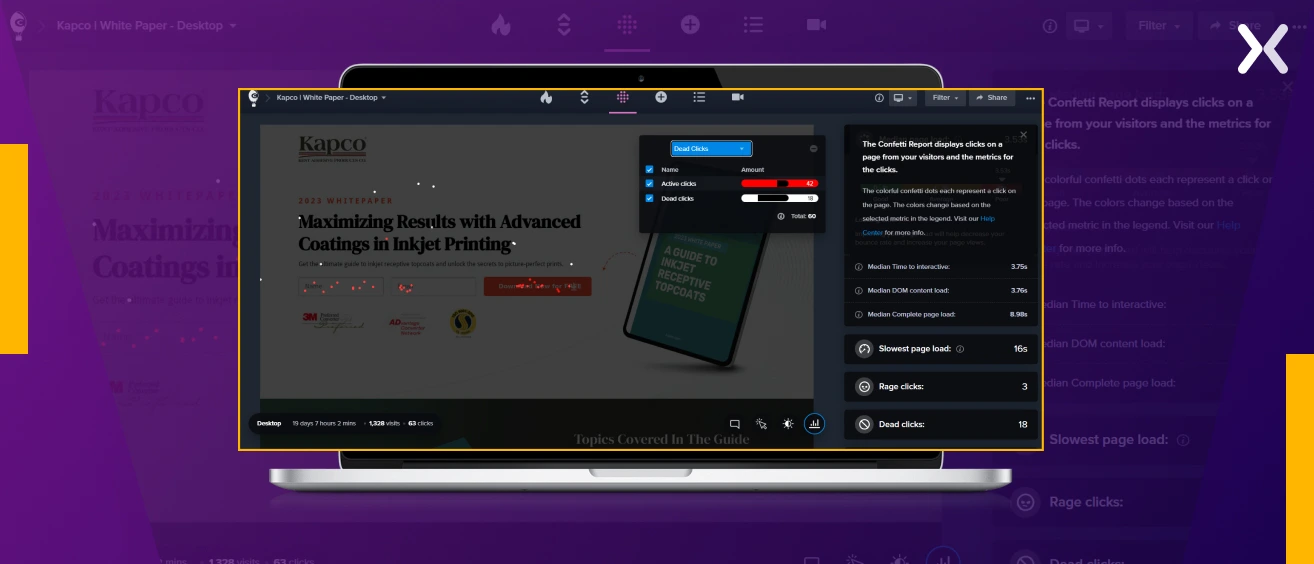
Key Features:
Click Heatmaps: Highlight where users are clicking the most on a webpage.
Scrollmaps: Reveal how far down the page users typically navigate.
Mouse Movement Tracking: Traces user attention and interaction levels.
Session Recordings: Video playbacks of individual user sessions.
Use Cases:
Determining points of high user engagement or interaction.
Finding out if users are missing or skipping over certain elements.
Popular Tools:
Hotjar
Crazy Egg
FullStory
Essential for conducting any efficient CRO testing maneuvers are testing tools. These purpose-built platforms and software streamline the process of setting up, running, and interpreting various tests so that you can get quantifiable and clear results.
Examples of Popular Testing Tools:
For those looking to conduct A/B testing, a well-regarded platform is Optimizely.
If both A/B and multivariate testing are on your radar, opt for a Visual Website Optimizer (VWO).
If you’re ready to launch into CRO testing, follow this straightforward four-step strategy:
Always validate the test idea through research and analysis into both internal and external avenues.
From an internal perspective, this means reviewing past experiments, user research data, and nuggets of insight gleaned from analytics. Externally, it’s a matter of studying your competitors’ strategies.
Your objective here is to unravel what has clicked with your audience in the past, making sure your proposed test is in sync with these findings.
Let’s consider the case of a research and analysis session conducted by Apexure for homepage CRO testing. Every homepage component is scrutinized and classed as good, bad, or improvable.
Notes clarify possible fixes, supplemented by an example section. This robust information will guide decisions on whether A/B or multivariate testing is the best route forward.
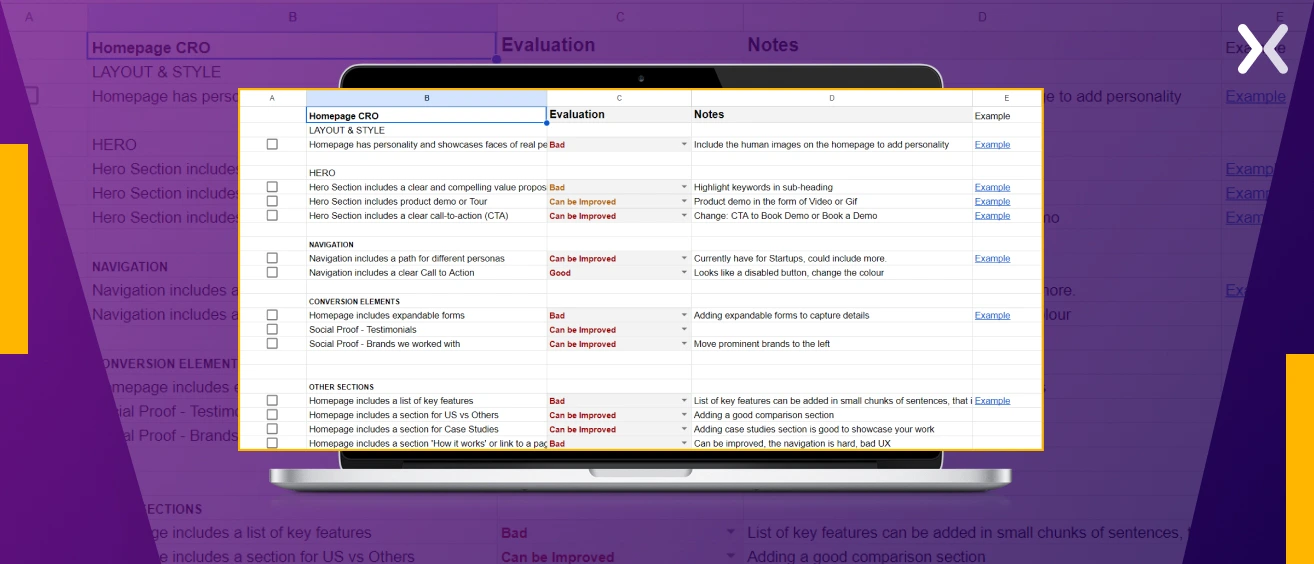
Charting a course for a CRO testing project requires strategy and forethought. You’ll want to focus your efforts where they can bring substantial gains through incremental but targeted shifts.
At the heart of our practice at Apexure, we swear by our EPIC framework:
Experiment/ Evaluation: The initial phase entails on the novelty, creativity, and learning potential of each test.
Priority: Based on urgency, tasks are ranked considering impact potential and cost implications.
Impact: We estimate the value an enhancement can bring in boosting conversions.
Cost: We take stock of the time and resources it will take to initiate a specific change or test.
This methodical application of the EPIC framework ensures our CRO actions garner maximum returns, homing in on high-impact zones while smartly routing our resources.
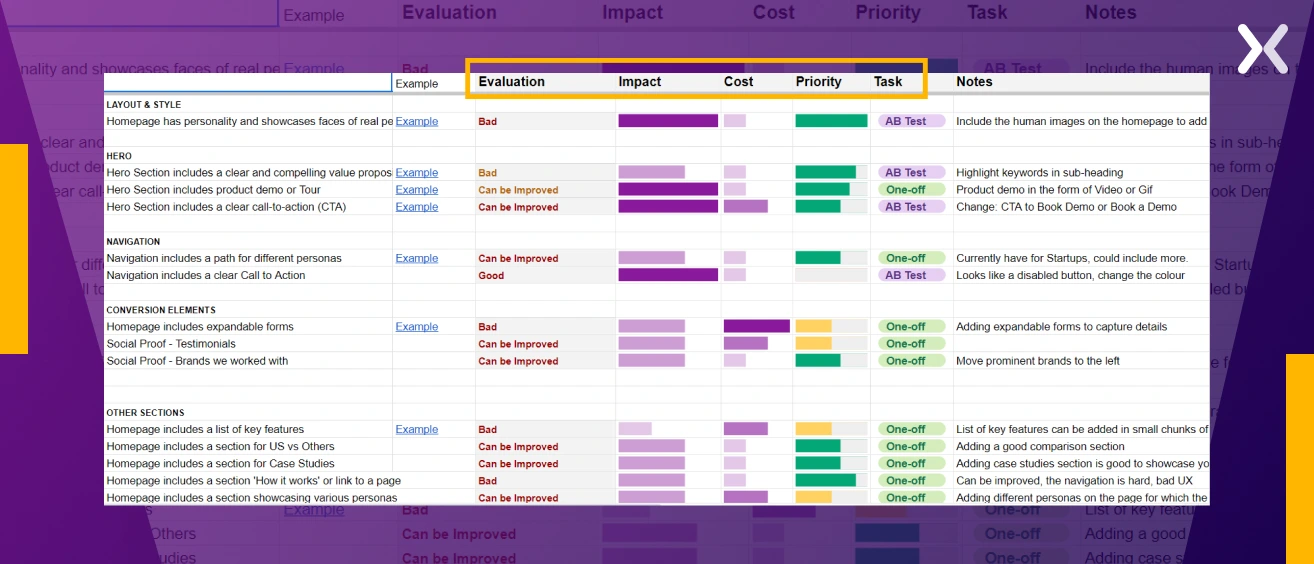
Now that you’re armed with a refined strategy, it’s time to breathe life into your experiment. Collaboration is key here, bringing together your team, designers, and developers to build a robust test.
Once your experiment is launched, quickly conduct quality assurance to check for operational efficiency. Even after a pre-launch review, live tests can occasionally expose bugs. Additionally, verify your analytics setup for accurate tracking.
After completing your review, keep your stakeholders in the loop. Since your test can have ripple effects on other team metrics, it’s crucial to keep everyone updated.
Arguably, the most exciting phase is analyzing your winning variant. Armed with the feedback from your analytics tools, you can keep track of all the data to discern the victor of your A/B test or to sift through survey responses.
Here is an example of how Apexure conducts its CRO A/B tests.
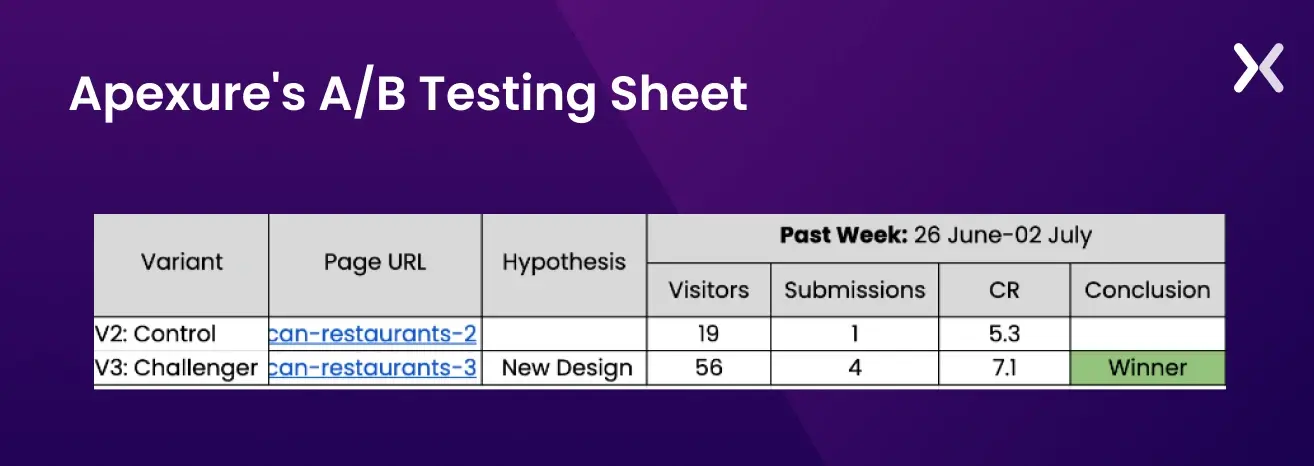
Once your test has achieved statistical significance, you’re all set to delve into the results. Remember, no outcome is a loss in CRO testing. Even a downward trend in your conversion rate offers valuable insights about your audience.
Let’s move on to exploring a few brand examples.
Take the example of a UK firm. Their intricate claim form required exhaustive, case-specific input beyond just personal details. This laborious process risked discouraging potential claimants, impacting lead volume and potential earnings.
Apexure stepped in with strategic CRO testing, which effectively streamlined this process and delivered superior results. We were able to boost their conversion rate from 4.33% to 6.09% with our given CRO testing framework.
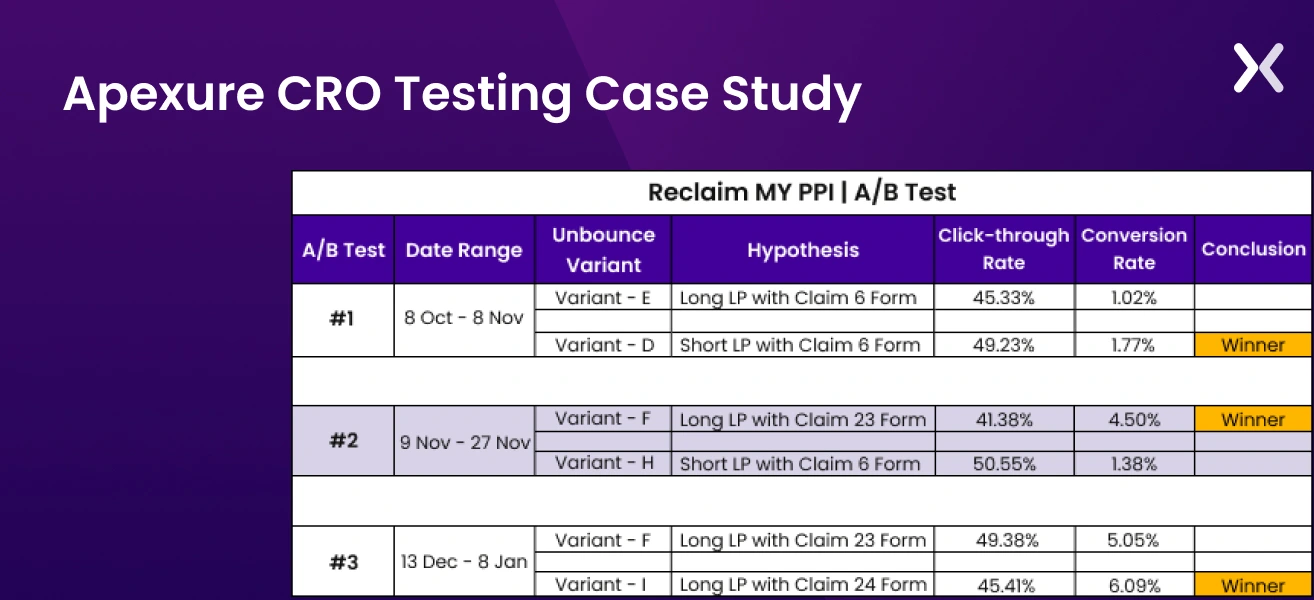
Integrating CRO testing into your marketing wheelhouse can amplify conversion rates and pump up your online visibility. As outlined in this guide, CRO testing is a systematic process of experimenting with diverse facets of your website or landing page.
Feeling swamped? Apexure, equipped with 8+ years of CRO industry experience, is here to help. We understand the nuances that can refine your websites and landing pages for peak conversions. So, if you’re seeking a reliable CRO agency, you’ve found your match.
Do you know Apexure has 100+ blog posts on landing pages and CRO? We have shared everything, from creation to testing, analysis to optimization.
Making a landing page on your own with just examples can take a lot of time. Get the help you need from our experts. Book a call and one of our experts will contact you soon.
Check out our landing page portfolio to discover conversion-friendly landing page elements that might. Filter your industry and check which landing page design is trending.
Without clear goals and KPIs, CRO efforts can become unfocused and misleading. Prioritizing tests based on impact and aligning with your objectives ensures meaningful improvements.
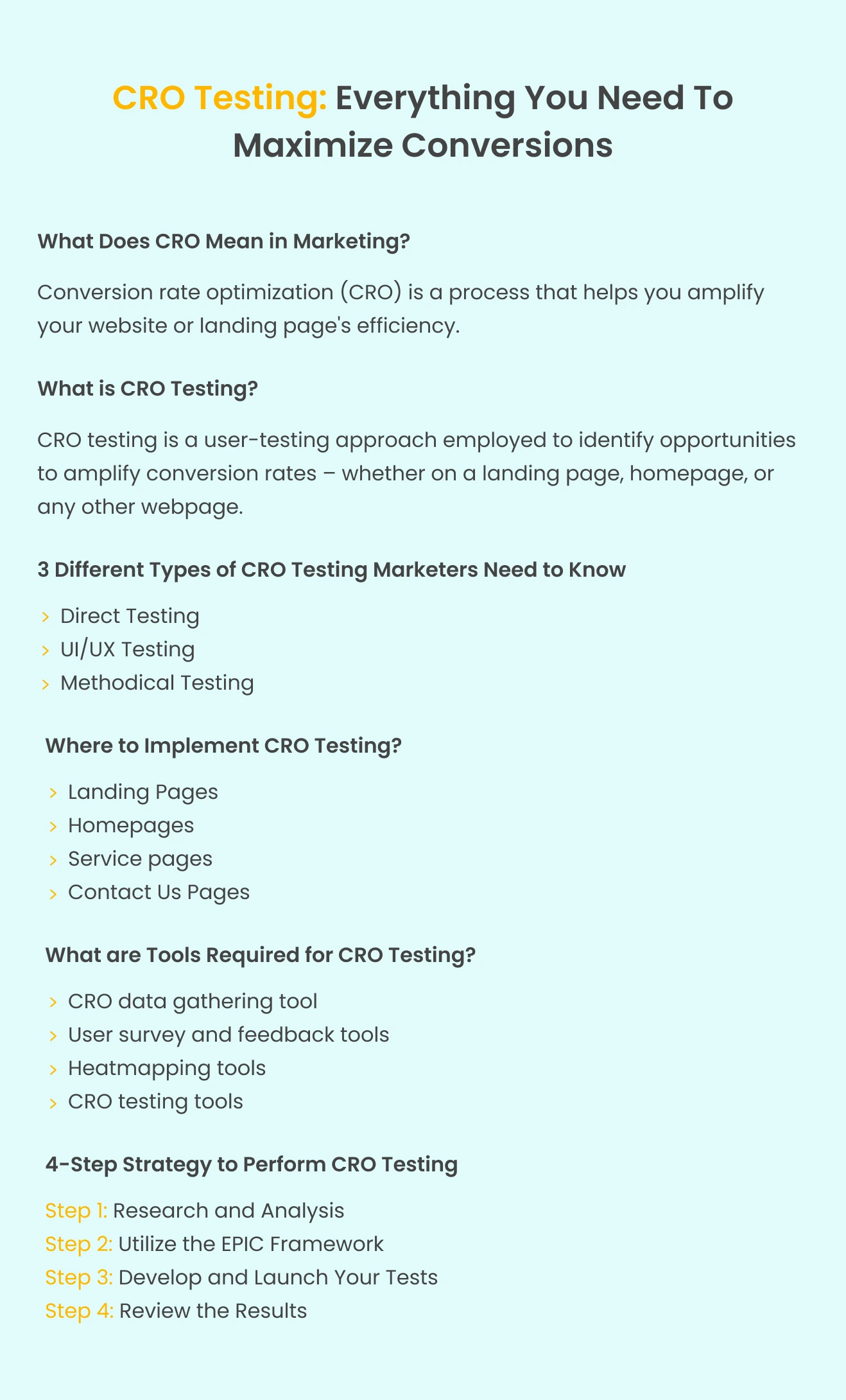
Related Articles:
Drive More Sales or Leads With Conversion Focused Websites and Landing Pages
Get Started
In today’s fast-paced digital world, having a responsive website is no longer just a nice-to-have, it’s essential. Whether...
As artificial intelligence continues to evolve, businesses are finding innovative ways to enhance their marketing efforts. One of...
Get quality posts covering insights into Conversion Rate Optimisation, Landing Pages and great design